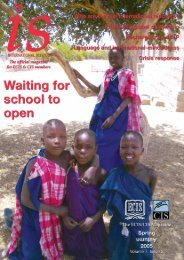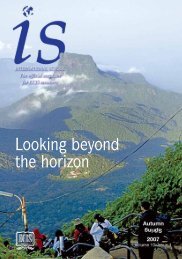is magazine 8.1 - Autumn/Spring 2005 - International Schools ...
is magazine 8.1 - Autumn/Spring 2005 - International Schools ...
is magazine 8.1 - Autumn/Spring 2005 - International Schools ...
You also want an ePaper? Increase the reach of your titles
YUMPU automatically turns print PDFs into web optimized ePapers that Google loves.
Planning a new school<br />
basic necessary conditions in h<strong>is</strong> explanatory article of social<br />
contact theory:<br />
● ‘…opportunities to become acquainted and develop friendships;<br />
● equal status among students from the different groups;<br />
● experiences that require inter-group cooperation to achieve a<br />
common goal;<br />
● ‘authority figures who encourage, model, and support comfortable<br />
inter-group contact and relationships’.<br />
Similarly to the teacher exerc<strong>is</strong>e above, Murthadra-Watts and<br />
D’Ambrosio (1997) suggest students share their life experiences,<br />
which may serve as starting points for teaching critical thinking,<br />
analysing oppression and alternative viewpoints.’<br />
One of the many d<strong>is</strong>courses of international teaching <strong>is</strong> the<br />
content of the instruction. D’Ambrosio (1995), referring to the<br />
recent advances in theories of cognition, claims there <strong>is</strong> a strong<br />
relation between culture and cognition. D’Ambrosio (1995) conceptual<strong>is</strong>es<br />
ethnoscience as ‘the study of scientific and technological<br />
phenomena in direct relation to their social economic and<br />
cultural backgrounds’. Th<strong>is</strong> point of view challenges the ethnocentric<br />
assumption that mathematics <strong>is</strong> largely a product of the<br />
men of European descent (Sleeter, 1997), thus creating a chance<br />
for students from diverse cultures to relate their cultural background<br />
and the subject. If students from diverse cultures meet and<br />
work together towards collaborative goals that have meaning in<br />
their lives (Johnson & Johnson, 1992) th<strong>is</strong> kind of relationship<br />
makes authentic learning occur. D’Ambrosio (1995) claims th<strong>is</strong><br />
<strong>is</strong> not a mere academic exerc<strong>is</strong>e, since its implications for the<br />
pedagogy of mathematics are clear.<br />
Teaching in an international community <strong>is</strong> both a unique situation<br />
and a unique challenge. It <strong>is</strong> also absorbing and rewarding.<br />
Sencer M Corlu teaches mathematics and ICT at Istanbul MEF<br />
<strong>International</strong> School, Turkey.<br />
Bibliography<br />
Bennett, C., (2001). ‘Genres of research in multicultural education’,<br />
Review of Educational Research. Washington: Vol.71, Iss. 2; pg.<br />
171, 47 pgs.<br />
D’Ambrosio, U. (1985). ‘Ethnomathematics and its Place in the<br />
H<strong>is</strong>tory and Pedagogy of Mathematics’, For the Learning of<br />
Mathematics 5, 1.<br />
Johnson, D. W., & Johnson, R. T. (1992). ‘Social interdependence<br />
and cross-ethnic relationships. Interdependence: Key to effective cooperation’.<br />
In J. Lynch, C. Modil, & S. Modil (Eds.), Cultural diversity<br />
in the schools (Vol. 11, pp. 179-190). London: Falmer Press.<br />
Murtadha-Watts, K., D’Ambrosio, B. (1997). ‘A convergence of<br />
transformative multicultural and mathematics instruction? Dilemmas<br />
of group deliberations for curriculum change’, Journal for Research in<br />
Mathematics Education. Washington: Dec 1997.<br />
Pepin, B. (1998) Paper presented at the European Conference for<br />
Educational Research, University of Ljubljana, Slovenia September<br />
17th to 20th.<br />
Sleeter, C.E. (1997). ‘Mathematics, multicultural education, and<br />
professional development’, Journal for Research in Mathematics<br />
Education. Washington: Dec 1997.<br />
A guide for planning<br />
a new school<br />
Walther Hetzer applauds the CIS Accreditation<br />
Instrument<br />
Anyone starting a school will sometimes sympath<strong>is</strong>e with the sentiment<br />
expressed by the great Austrian cabaret art<strong>is</strong>t Helmut<br />
Qualtinger: “I don’t quite know where I am going but at least I’ll<br />
get there more quickly”. While the notion of speed has its appeal,<br />
a careful look at some roadmaps in detail <strong>is</strong> essential before roaring<br />
off into the unknown. One such useful map can be found in<br />
the CIS accreditation instrument (seventh edition).<br />
Among the character<strong>is</strong>tics of an accredited school, CIS l<strong>is</strong>ts:<br />
‘The school knows itself. It has thought deeply about the services<br />
it offers to students, family, and community.’ A new school obviously<br />
cannot evaluate past and present services but it will think<br />
(one hopes deeply) about the services it intends to offer, about the<br />
indicators and standards by which planning, implementation, and<br />
– in due time – accreditation will be guided.<br />
Many of us know from experience how the preparation of a critical<br />
self study and the ensuing verification by a v<strong>is</strong>iting team can<br />
lead to productive and focussed talks with board members, teachers,<br />
students and parents. A bit of stress as well, no matter how<br />
much the team members emphas<strong>is</strong>e that they do not v<strong>is</strong>it as<br />
‘inspectors’. Accreditation does indeed focus a school on its m<strong>is</strong>sion<br />
and helps ascertain whether a school’s claims are being fulfilled.<br />
The resulting follow-up on any recommendations ensures that<br />
th<strong>is</strong> focus <strong>is</strong> not blurred even after the coveted ‘seal of approval’ <strong>is</strong><br />
received. Establ<strong>is</strong>hed schools know where they have been and<br />
where they are going. Th<strong>is</strong> <strong>is</strong> not the case with schools in the<br />
planning phase, even if the future school community <strong>is</strong> clear<br />
about their m<strong>is</strong>sion and goals.<br />
I have not, until now, fully appreciated to what extent an<br />
accreditation instrument can contribute to the development plan<br />
of a new school. So far I have been a ‘customer’ of accreditation<br />
services within well-establ<strong>is</strong>hed schools; involved in preparing the<br />
self-study, the team v<strong>is</strong>it, and the subsequent follow-up.<br />
I have also served on numerous v<strong>is</strong>iting teams. On one occasion<br />
th<strong>is</strong> was in a school at an early stage of development, and the<br />
excitement and spirit of creating a very special school and ‘living<br />
its m<strong>is</strong>sion’ was tangible. For a school which has not even opened<br />
its doors the instrument, with its clear standards and indicators for<br />
most aspects of school life, provides a useful check and a host of<br />
questions related to future philosophy, organ<strong>is</strong>ation, or educational<br />
prov<strong>is</strong>ions.<br />
The Development Plan of the St Gilgen <strong>International</strong> School<br />
makes use of applicable categories of the seventh edition and liberally<br />
quotes from it (no charges of plagiar<strong>is</strong>m since Gerry Percy <strong>is</strong><br />
duly notified of th<strong>is</strong> fact). Like other such plans, it states an overall<br />
goal for each section, l<strong>is</strong>ts the main strategies env<strong>is</strong>ioned for<br />
reaching th<strong>is</strong> goal, and adds corresponding action steps with an<br />
indication of expected timing and assignment of responsibility for<br />
each step.<br />
Much of the scope and language of the future accreditation<br />
process will thus already be familiar to everyone involved in setting<br />
up the school. The effectiveness of the plans will obviously have to<br />
30<strong>Spring</strong><br />
<strong>is</strong> <strong>Autumn</strong> <strong>2005</strong>




